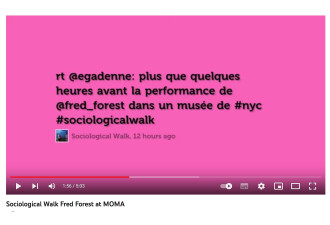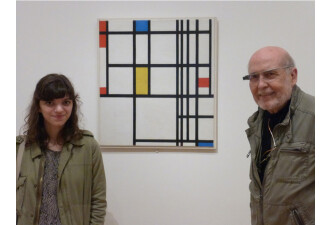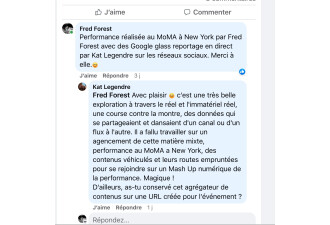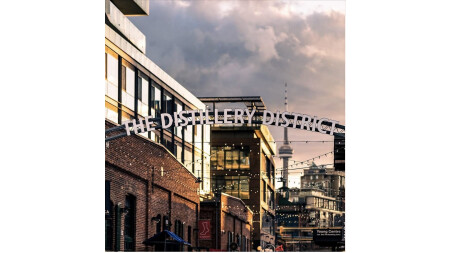MoMA Google Glass
The sociological walk, or augmented visit, of which I am the instigator, without having received the slightest mandate to produce it at MoMA, aims to question the Institution. It's an integral part of an approach to institutional criticism known as sociological art.
MoMA GOOGLE GLASS OU PROMENADE SOCIOLOGIQUE
MoMA NEW YORK, 9 Mai 2014
COMMUNICATION
TO FOLLOW THE PROGRESS OF THE AUGMENTED VISIT IN REAL TIME ON SOCIAL NETWORKS: Live reporting on Facebook and Twitter
CONCEPT
DISRUPTEUR" is a kind of original performance by the artist, whose aim was to question the status of performance art, which he has replaced with "a visit" or "sociological stroll" in the museum, since performances have been forbidden there since 2011, as the videos below demonstrate (1).
Yes, forbidden to anyone who hasn't received a formal invitation from the museum's administrators to take part.
See his unfortunate experience of September 23, 2011
As this was a strictly personal visit or stroll, in which he did nothing more, hands in pockets like any other visitor, than contemplate the works in the permanent collections, following a duly established itinerary, he was not, in principle, subject to any prohibition...
In so doing, with a simple slip of the tongue and the appropriate minimum gestures, the artist has made possible on his own initiative, overnight, what was still forbidden in the museum the day before... This raises the question of the status of performance art, of the artist's freedom to define it, of his room for maneuver and power in relation to that of the museum, of the meaning given to the artistic gesture in the institutional setting, of its appreciation as such by the public present, of the skills and competence of those who lay down the rules in all relativity and, finally, of its added value to become, quite simply in the end, with the implicit endorsement of the museum, a commercial object among others, in the contemporary art system...
MAY 10, 2014 at 3 pm at L'AC INSTITUTE NEW YOK: DEBATE/ CRITIQUE/ DEBRIEFING ON THE "SOCIOLOGICAL WALK" PERFORMED THE EVENING AT MoMA BY FRED FOREST, IN PRESENCE OF :
- HOLLY CRAWFORD Ph.D., Director, Editor of AC Institut
- STEPHANIE JEANJEAN Ph.D,
- FRED FOREST, Artist, Doctor of State from the Sorbonne, Professor Emeritus from the University of Nice
Assistants: Jean-Guillaume Le Roux and Stéphanie Jeanjean on site, Yvana Samandova from Paris
MoMa Google Glass or sociological walk
DOUBLE TRANSGRESSION AT MoMA OR THE ART OF COMMUNICATION STRATEGY
The sociological walk, or augmented visit, of which I am the instigator, without having received the slightest mandate to produce it at MoMA, aims to question the Institution. It is an integral part of an approach to institutional criticism known as sociological art. One of its aims is to question the museum about the nature of the objects it validates as works of art. The point of my demonstration is to establish the difference between those objects which, by virtue of the museum's power and arbitrariness, have the legitimacy to be presented or even produced within it as "works of art", and... the others.
And to observe how, through a subtle play on language, the artist can seamlessly move these objects from one category to another and vice versa?
What, then, is the exact status of the performance I'm about to produce (which I produced at MoMA on May 9, 2014, equipped with Google Glass, which enabled me to escape the absolute ban on taking photos. The MoMA security guards were still unaware of what this new tool, whose technology had just been perfected by Google, easily enabled without their knowledge and with the utmost discretion).
It should be noted that two years earlier, on September 23, 2012, the MoMA administration had had me neutralized by its security service to prevent me from carrying out a performance. A performance also carried out without having been invited by MoMA, which I had publicized extensively in the press, under the title "Invisible Square Meter". An action supported and theorized during his lifetime by the art critic Pierre Restany...
MoMA, as I had foreseen, justified its ban on the grounds that, being a private venue, no one could arrogate to himself the right to perform there without having been duly invited... This denotes the abuse of its curators, who alone decide on the value of artists in general, and of an undemocratic system that decides arbitrarily. The fact that MoMA is privately owned in no way gives it this right, given that it represents the entire American nation and benefits from its aura. As a result, MoMA must move from private to public status and meet its democratic requirements.
Because of its inability to anticipate, MoMA, like a chess player who is one move behind his opponent, has not had time to adapt to an artistic strategy that I have been working on for a long time. A strategy that had not only banked on this probable ban and its consequences, but above all on the opportunity for me to create a new work on this occasion.
A critical work in line with the principles of sociological art. The communication strategy used consisted in launching the "artistic square metre" performance like a decoy. This was done through a press release relayed by social networks and the New York art community. The information was aimed primarily at MoMA's management team, waiting to see what would happen on the day in question...
A maneuver which, according to my forecasts, would lead to an inevitable ban, allowing me to create a "second work" to replace the one that had been publicly announced. This undoubtedly happened, in accordance with the programming I had anticipated. All I had to do was substitute the title "The conversation" for "Mètre carré invisible", and by a simple play on language, the conditions for the creation of a new, critical video work, as I had originally conceived it, were met.
A work whose essential staging, like its contents, was to be constituted by the involuntary and unknowing participation of MoMA's security services in my performance. Which, according to my predictions, was exactly what happened, as the security guards mobilized around me to neutralize me. They even threatened me, talkiewalkie in hand, with immediate arrest by the New York police, should I persist in my project. They had no idea that at that very moment, trapped by my stratagem, they themselves were already unwittingly taking part in the filming of "The Conversation".
As soon as I stopped at the top of the steps leading to the platform overlooking the garden I had chosen as the strategic location for my performance, I was quickly surrounded by five security guards ordering me to stop my performance immediately...
Four men and a woman in uniform, to whom I naturally offered no resistance, surrounded me. My intention was to maintain the "Conversation" with them for as long as possible, so as to give my video assistant all the time she needed to record my action... and thus constitute the work planned under the name of "The Conversation". Another MoMA security guard stood by my video assistant, trying to prevent her from filming, as can be seen on the video. While a second, more discreet video assistant moved closer to the garden, with her back to him, and carried out her English-language report without being noticed... (See video)
The whole affair went as well as I'd expected, and I almost jumped for joy at the neck of the head of security. A tall black guy who was actually quite nice, and who towered over me by three heads. Who, noticing that I was in no way aggressive and willing to obey his orders to put an end to my performance of the Invisible Square Meter, almost showed me active sympathy...
A conversation ensued with the group of security guards surrounding me about the validity of this ban imposed by the museum administration. I'd like to point out here, not without a touch of irony, that this transgressive production was produced from start to finish, with the kind assistance of these security guards, dispatched urgently by MoMA's management.
From the moment my work, the aptly named "The Conversation", was in the process of being fully finalized according to my wishes, I engaged in a convivial and highly interesting conversation with them, and more specifically with the head security guard, who even admitted to me, in the hollow of his ear, that he himself was... an off-duty painter! And by the same token, his implicit regret at having had to interrupt my action solely because of his duties within the establishment.
This in itself raises the question of the status of personnel at MoMA... as well as all the ambiguity, vacuity, elasticity and relativity of the status of performance and its authorization in the Museum, as we are posing it here.
After this first fruitful experience, MoMA proved to be a promising field of experimentation for me, where I could develop a sociological art practice based on institutional critique. So I decided to try again as soon as possible...
Mindful, however, of the fact that MoMA is a private museum, and that no artist or creative citizen could claim this status and perform there without running the risk of being immediately arrested by the New York police, like a common delinquent...
This rather lengthy detour, for which I apologize to the reader in a hurry, was nevertheless necessary to grasp the context in which my current project, still feasible at MoMA, known as the "Sociological Walk" or "Augmented Visit", took shape. A kind of private visit, which I plan to make there on Friday, May 9, 2014 between 4:30 and 6:00 pm (New York time).
I prefer to take all the necessary precautions here in terms of language vis-à-vis the MoMA administration, to make it clear that this time it's by no means a "performance" in the strict and literal sense of the word, but rather a "walk" or "visit", so-called sociological. This is to ensure that there is no confusion between two essentially different things (and yet, in certain respects, perfectly identical...) Two eminently distinct things: the performance, on the one hand, and the sociological walk, on the other.
As far as performance is concerned, the various etymological meanings of the term are quasi-organically linked to behavioral criteria, themselves dependent on notions of body, space and time. These are subject to more or less rigorous protocols, some of which may refer to rituals, ceremonies, rites of passage, whether religious, social, corporate, political, sporting or other. As a result, performances are also bound up with intrinsic notions of the public (with its "viewers" and "actors"), as well as the specific places in which they take place (museums, art galleries and sometimes even certain urban spaces).
My visit to MoMA had none of this, and was that of an exemplary ordinary visitor. The visitor walks by himself along the picture rails. Stop for a moment in front of a work that has caught your eye. Contemplate it. Up close, or from a distance. Moves on. Stops again. Stops again.
Everything normal in terms of physical appearance and behavior, compared to the average visitor. He continues on his way, with no distinctive signs of dress, no particular gestures, and no use of his vocal organ other than, if need be, to ask the attendant in a low voice for the location of a work of art, unless it's the direction of the toilets...
Throughout my sociological stroll, therefore, I shall endeavor to be essentially myself during this visit, i.e., a French artist passing through New York who comes to visit MoMA as an enlightened and, as far as possible, anonymous (?) amateur.
But my God! What if the gaze of others, against which I can't defend myself, were to see me, at that very moment, as putting on a performance? ? ? ?
Would I then have to step out of my reserve, my declared neutrality, and run the risk, in the eyes of MoMA's administrators, of entering dangerously into the "doing" of a reprehensible performance? A performance that in reality would not be one!
Addressing myself directly to all those people watching me, expecting me to say something? A sign? A gesture? A shout? An artist's antics? Having recognized and identified myself for who I really am (an artist), I now find myself obliged to let them know explicitly. To let them know that this is in no way a Fred Forest performance they're witnessing, but simply a "sociological walk".
The latter, of course, with no signs to distinguish it from a normal visit to the museum by any ordinary person.
At first, I called out to this burgeoning crowd with restrained moderation, and then, failing to be heard, I came out of my reserve with a little more vehemence, urging them to please move on without looking at me!
Thus exposing myself to the vindictiveness of the MoMA security guards, who could appear at any moment to arrest me on the pretext of a performance offence...
No! That would be too easy. I won't fall into the trap set for me. I'll keep my composure despite the stares of others. Settling into my role as a normal visitor, I'll continue my individual visit to MoMA as if nothing had happened.
On the other hand, once my visit is over, what if, as soon as I take my first step out of the museum, out of reach of its watchdogs and their threats, I affirm to anyone who will listen - in other words, to the people I meet on the sidewalk, or now to the whole world through the amplifying effect of social networks - that I have indeed just made a performance? Where does the distinction really lie?
Yes, ladies and gentlemen, a performance! A performance in this mythical and sacrosanct place called MoMA! A performance under the noses of its curators and without their authorization. A performance that took place under the noses of its curators and without their authorization. An artist has defied the abusive prohibitions of the politico-financial power of the world art establishment in a victorious manner through a simple play on words. A symbolic victory, to be sure, but one that demonstrates, if proof were needed, that the use of force is not the only way to work towards greater justice in our societies. Intelligence and cunning can also be indispensable allies.
So this performance was not a performance at all. A verifiable factual truth, after the fact, as indubitable proof: the museum's surveillance camera recordings. Provided the museum is willing to make the tapes available to anyone who would like to see them?
The "sociological walk", a performance whose project was to do nothing other than play the role of a visitor like any other, without making a single gesture.
What political, administrative or intellectual authority would be in a position to contest this? To claim that my "non-performance" with the "Sociological Walk" I've just taken in the museum is in no way a performance?
The objective of my action, based on the "Promenade sociologique" carried out today at MoMA, was thus fully achieved, in accordance with the principles of sociological art, whose theoretical foundations are those of institutional critique. This action aims to demonstrate :
- That the use of the most advanced technologies, such as Google Glass, can add value to the classic museum visit.
- That the prohibitions and dogmas of a great institution like MoMA can be subverted and transgressed thanks to the tricks of semantics, a pinch of humor and a dash of impertinence.
- That questioning the status of performance art and bringing it up to date in the contemporary art system by means of an unprecedented modus operandi remains eminently possible, for those willing to take the trouble, and within the very power that dictates its standards to artists and to society as a whole.
- That cultural power can and must belong first and foremost to artists, to men and women of good will, and to those who are motivated, convinced and patient enough to legitimately appropriate it.
- That technological communication strategies using, among other things, social networks and marketing tools, from an artistic perspective, can now be considered an integral part of artistic practice. A practice for which they constitute a decisive asset, encouraging detour and the emergence of complex thinking operating in loops. In this respect, the informational and dematerialized "objects" that artists now manipulate with an assertive aesthetic approach can be seen as nothing other than a new category of "readymade" belonging to the information society.
- That the reporting carried out in real time via FaceBook and Twitter by a dozen assistants as the sociological walk unfolds, followed around the world, contributes to this problematic, while extending the scope of this performance outside the museum to other geographical and virtual spaces.
- That in art, no rule, theory or convention can be accepted once and for all, and that only the evolution of models can find, for a moment, the appropriateness for a given moment in society, under the impetus and initiative of artists.
Fred Forest
-------------------------------
05/04/2014 LA VISITE AUGMENTEE DE FRED FOREST AU MoMA
THE ART OF TRANSGRESSION AT MoMA OR DISRUPTION AGAIN
A PERFORMANCE THAT ISN'T ONE AND...YET IS ONE!
Today, Friday May 9, 2014, between 04:30 PM and 06:00 PM a "sociological walk" or "augmented visit" by French artist Fred Forest took place in MoMA's permanent collections.
TO FOLLOW THE PROGRESS OF THE AUGMENTED VISIT IN REAL TIME ON SOCIAL NETWORKS, WE INVITE YOU FIRST TO TAKE NOTE OF THE FOLLOWING LINK
https://www.youtube.com/watch?v=lWs5Xq61bTY
DISRUPTEUR" is a kind of original performance by the artist, whose aim was to question the status of performance art, which he has replaced with "a visit" or "sociological stroll" in the museum, since performances have been banned there since 2011, as demonstrated by the videos above (1).
Yes, forbidden for anyone who hasn't received a formal invitation from the museum's administrators to perform in the museum.
See her unfortunate experience on September 23, 2011
As this time in 2014 it was only a strictly personal visit or stroll, in which he did nothing more, hands in pockets like any other visitor, than contemplate the works in the permanent collections, following a duly established itinerary, he did not, in principle, fall under any prohibition...
In so doing, with a simple slip of the tongue and the minimum appropriate gestures, the artist made possible on his own initiative, from one day to the next, what was still forbidden the day before in the museum... If one must commonly call a spade a spade, he would not hesitate in this circumstance to call a cat a dog, which for him, here, was perfectly equivalent!
In this way, he raises the question of the status of performance art, the artist's freedom to define it, his room for manoeuvre and power in relation to that of the museum, the meaning given to the artistic gesture in the institutional setting, its appreciation as such by the public present, the skills and competence of those who lay down the rules in all relativity and, finally, its added value to become, quite simply in the end, with the implicit guarantee of the museum, a commercial object among others, in the contemporary art system...
FRIDAY, MAY 10, 2014 at 3 pm at AC INSTITUTE NEW YOK: DEBATE/ CRITIQUE/ DEBRIEFING ON THE "SOCIOLOGICAL WALK" PERFORMED THE EVENING AT MoMA BY FRED FOREST, IN PRESENCE OF HOLLY CRAWFORD Ph.D., Director, Editor of AC Institut, STEPHANUE JEAJEAN Ph.D, FRED FOREST Artist, Doctor of State from the Sorbonne, Professor Emeritus from the University of Nice.
Assistants: Jean-Guillaume Le Roux (sur place) et Yvana Samandova (à Paris)
AC Institute
547 W. 27th St, 6th Floor, #610
New York, NY 10001
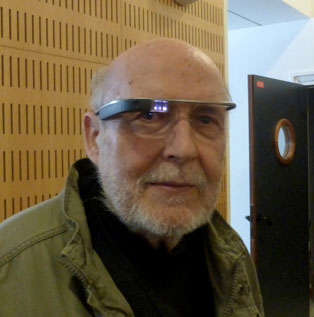

- http://www.artshebdomedias.com/article/100514-fred-forest-new-york-art-du-defi/
- France – Amérique : Que viens faire Fred Forest à New York par Nathalie Moga, 2014-05-02
LONG BIOGRAPHY OF FRED FOREST
Fred Forest has a special place in contemporary art. Both by his personality and by his pioneering practices which mark his work. He is mainly known today for having used one by one most of the communication media that have appeared over the last fifty years. He is co-founder of three artistic movements: those of sociological art, the aesthetics of communication and ethics in art.
He represented France at the 12th São Paulo Biennale (Communication Prize) in 1973, at the 37th Venice Biennale in 1976 and at Documenta 6 in Kassel in 1977.
EXHIBITION AT THE CENTRE POMPIDOU FROM JANUARY 24 TO OCTOBER 14, 2024

